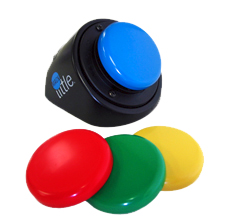The purpose of sharing these completed IEPs is to help educators become familiar with different types of assistive technology devices and how those devices helped certain students. This relates to the classroom because if a student in your classroom is displaying any similar characteristics as a student below, you may want to consider if that assistive technology device would benefit them in the classroom!!
1) Eric
 |
| The ALPHASMART 3000 portable word processor |
Annual Goal: Eric will use a computer or portable word processor to complete 100% of his assignments in 10th grade English and Civics classes.
(Wisconsin Assistive Technology Initiative).
2) Mary
Present Level of Academic
Achievement and Functional Performance: Mary currently communicates with sounds that are not always
understood by those around her. She often becomes upset when she is not
understood. She likes people and likes to be around both adults and children.
She is beginning to play simple games.
 |
| Single Message Voice Output Device |
Annual Goal: Mary will communicate her interests and needs in three or more
environments/situations using a single message voice output device.
Short Term Objective (STO)
1: Using a single message voice output
device, Mary will communicate when she wants to change activities during play
time on three out of five opportunities on three consecutive days.
STO 2: Mary will use the single message device to interact with others during
games, such as Peek-a-Boo on three out of five opportunities on three
consecutive days.
STO 3: Mary will initiate communication by “calling” someone using a
preprogrammed message on a single message voice output device on three out of
three opportunities on three consecutive days.
3) Kelly:
Present Level of Academic Achievement and Functional Performance: Kelly is in the third grade classroom for most of his day. He has a full time paraprofessional who assists him. He is unable to use a standard keyboard because of his physical limitations. Additionally, his speech is frequently unintelligible. He currently uses single message and multiple message voice output devices, eye gaze, and limited direct selection to complete his academic work. Kelly is functioning at about the second grade level in most curricular areas.
 |
| Talking Word Processor for the computer. |
Annual Goal: Kelly will use an adapted keyboard with custom overlays and a computer with talking word processing to complete all academic work.
STO 1: Using an adapted keyboard with a custom spelling template, Kelly will complete a 10 word weekly spelling test taken from second grade curriculum and his current reading materials, with 80% accuracy once a week.
STO 2: Using an adapted keyboard with a custom overlay with three character names and facts or characteristics about them from a current reading selection, Kelly will generate three sentences describing a character or their actions with 100% accuracy on three out of four opportunities.
| Adapted Keyboard with a custom overlay |
STO 3: After participating in a cooperative group science project, Kelly will use an adapted keyboard with a custom overlay that randomly lists three to five steps involved in the science project to sequence the steps in proper order with 80% accuracy and "read" them to his group as the "recorder" on three out of four opportunities.
STO 4: Using a basic numbers overlay on an adapted keyboard, Kelly will complete his adjusted daily math assignment with 100% accuracy on four out of five opportunities.
(Wisconsin Assistive Technology Initiative).
4) Steven:
Present Level of Academic Achievement and Functional Performance: Steven is a four-year-old boy diagnosed with pervasive developmental disorder. His placement is in an Early Childhood classroom. He is able to understand and comprehend when spoken to, but does not communicate his needs consistently. When choices are simplified and broken into steps, Steven will try to communicate wants and needs. Peer interactions are limited.
 |
| Sample Picture Board |
Annual goal: Steven will use a picture board or voice output device to express wants and needs to adults and peers in both home and school at least four times each day.
STO 1: During meal times at school and at home, Steven will use a picture board to point to at least three of six foods he wants to eat, two of three meals each day.
 |
| The Listen To Me Voice Output Device |
STO 2: Using a voice output device, Steven will make a choice of a “center” he wishes to participate in during choice/work time three or four days per week.
STO 3: During group story time, Steven will use a single message voice output device to complete a repeated story line with peers 90% of the time as observed on 10 random trials.
(Wisconsin Assistive Technology Initiative).
5) Becky:
Present Level of Academic Achievement and Functional Performance: Becky is learning to read and is anxious to complete writing assignments with her peers. She is not able to produce handwritten material due to severe spastic quadriplegia. Becky is interested in using the computer and has been introduced to it. The staff has helped Becky experiment with several switches in a variety of locations. She seems to be most accurate using a switch mounted next to her head.
 |
| A Switch-mounting arm |
Annual Goal: Becky will use a single switch mounted on a switch-mounting arm positioned to the right side of her head and scanning software to access the computer 9 out of 10 times for a variety of educational assignments.
(Wisconsin Assistive Technology Initiative).
The devices you selected are great for each student.
ReplyDelete